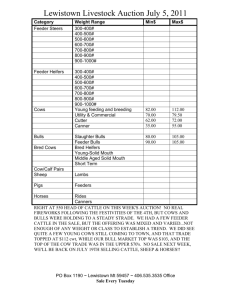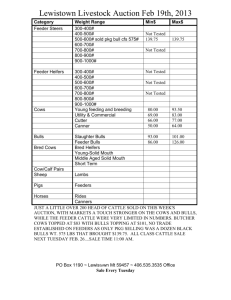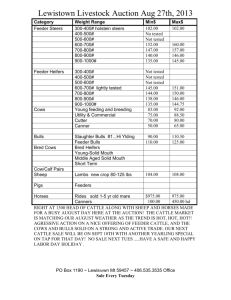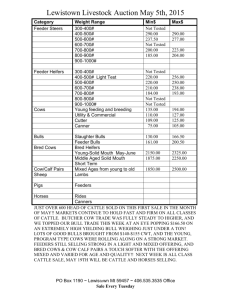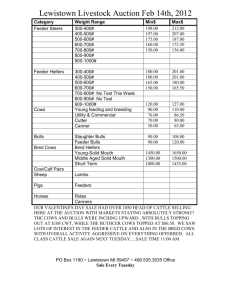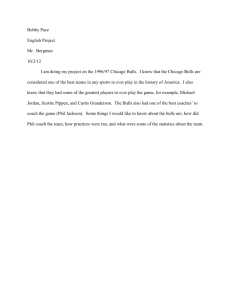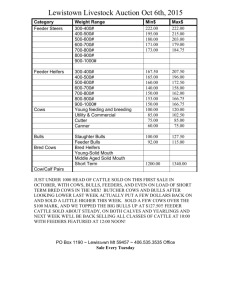Development of the Sunandini cattle breed in India
advertisement
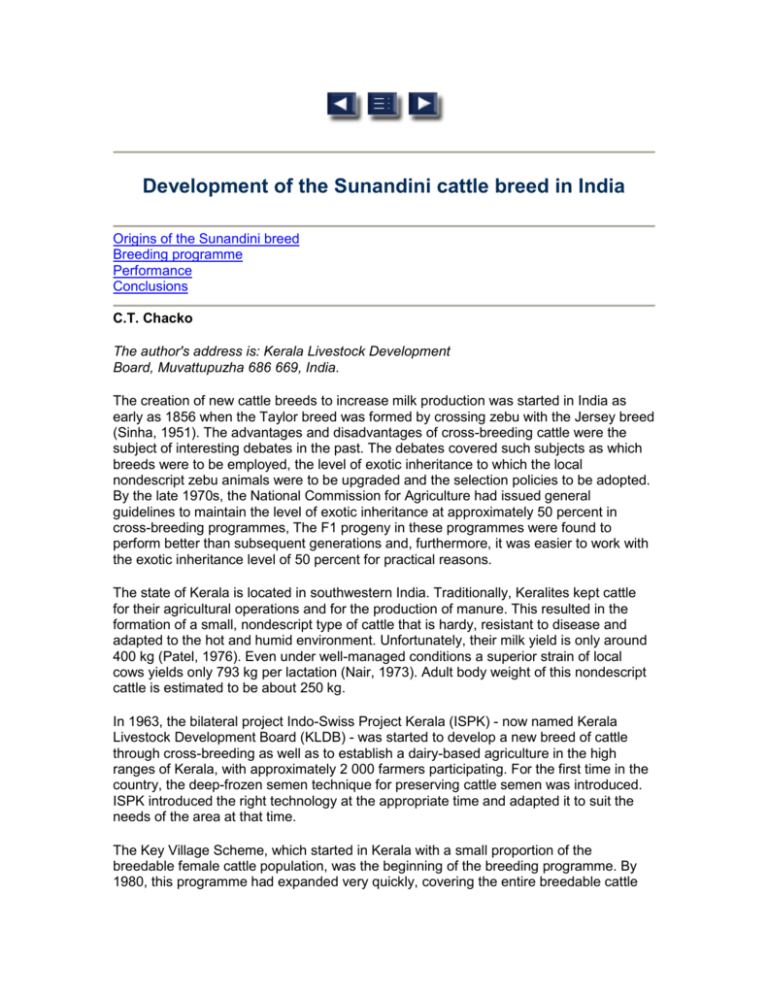
Development of the Sunandini cattle breed in India Origins of the Sunandini breed Breeding programme Performance Conclusions C.T. Chacko The author's address is: Kerala Livestock Development Board, Muvattupuzha 686 669, India. The creation of new cattle breeds to increase milk production was started in India as early as 1856 when the Taylor breed was formed by crossing zebu with the Jersey breed (Sinha, 1951). The advantages and disadvantages of cross-breeding cattle were the subject of interesting debates in the past. The debates covered such subjects as which breeds were to be employed, the level of exotic inheritance to which the local nondescript zebu animals were to be upgraded and the selection policies to be adopted. By the late 1970s, the National Commission for Agriculture had issued general guidelines to maintain the level of exotic inheritance at approximately 50 percent in cross-breeding programmes, The F1 progeny in these programmes were found to perform better than subsequent generations and, furthermore, it was easier to work with the exotic inheritance level of 50 percent for practical reasons. The state of Kerala is located in southwestern India. Traditionally, Keralites kept cattle for their agricultural operations and for the production of manure. This resulted in the formation of a small, nondescript type of cattle that is hardy, resistant to disease and adapted to the hot and humid environment. Unfortunately, their milk yield is only around 400 kg (Patel, 1976). Even under well-managed conditions a superior strain of local cows yields only 793 kg per lactation (Nair, 1973). Adult body weight of this nondescript cattle is estimated to be about 250 kg. In 1963, the bilateral project Indo-Swiss Project Kerala (ISPK) - now named Kerala Livestock Development Board (KLDB) - was started to develop a new breed of cattle through cross-breeding as well as to establish a dairy-based agriculture in the high ranges of Kerala, with approximately 2 000 farmers participating. For the first time in the country, the deep-frozen semen technique for preserving cattle semen was introduced. ISPK introduced the right technology at the appropriate time and adapted it to suit the needs of the area at that time. The Key Village Scheme, which started in Kerala with a small proportion of the breedable female cattle population, was the beginning of the breeding programme. By 1980, this programme had expanded very quickly, covering the entire breedable cattle population of 1.8 million through various other projects. The positive response of the farmers, coupled with intensive extension work and supported by a smooth-running technical programme, made it possible to achieve fruitful results from artificial insemination (AI). This intensive cattle-breeding programme resulted in a substantial change in the structure of the cattle population. A review of various livestock census figures indicates that the population is being transformed into one with a higher number of cross-bred cattle (Figure 1). It can be seen from Figure 1 that the shift to cross-bred cattle has increased in the last few years. In 1992, the estimated proportion of cross-bred cattle among breedable females was 56 percent. The ratio of adult males to adult females had shifted from 30:70 in 1966 to 8:92 in 1987, indicating the reduced use of working males and the increased use of milking cows. Figure 2 shows the change in the population structure according to sex. Origins of the Sunandini breed The origins of the Sunandini in India can be traced to the importation of 22 Brown Swiss bulls and 45 cows during the period from 1964 to 1967 (Crettenand and Chacko, 1976, personal communication). The bulls were mated to a nucleus stock of 140 nondescript cows. Subsequently, semen from 11 more bulls was imported. Information collected from various sources indicates that about 40 Jersey bulls were used in the cross-breeding programme. Most of these bulls were of Australian or New Zealand origin. Table I gives an account of the exotic bulls involved in the breeding programme. The KLDB imported two consignments of exotic bull semen for the production of F1 bulls. These included Jersey, American Brown Swiss and Holstein. The major component of zebu in the Sunandini breed is the local nondescript cattle of Kerala, even though one or two attempts have been made to introduce Sahiwal, Gir and Kankrej into the population. Cows of these breeds were employed for the production of F. bulls. Their impact on the Sunandini population was not significant. It can be seen later on in the article that the Sunandini breed is currently undergoing changes with respect to its objective, genetic content and characteristics. Originally conceived as a multipurpose breed for milk, draught and meat, it is now becoming solely a milk breed. Breeding programme Characteristics of the Sunandini breed While drawing up the characteristics of the breed, importance was given mainly to its economic, rather than phenotypic, characteristics. This was all that was possible because of the mixture of different exotic breeds in this synthetic breed. Before the original Brown Swiss cross - type of animal was mixed with Jersey and later Holstein blood, it had a uniform phenotypic appearance with a short flat head, small ears, short thick horns projecting outwards and curving inwards and a body colour ranging from light grey to black. With the introduction of the Jersey and Holstein inheritance, however, the phenotypic appearance of the Sunandini has become heterogeneous. The only phenotypic characteristic that can now be considered typical to the Sunandini is the straight back and comparatively short flat head. The colour varies from different shades of grey to brown. A Sunandini cow - Vache Sunandini - Vaca Sunandini A herd of Sunandini cows on pasture - Troupeau de vaches Sunandini au pâturage - Hato de vacas Sunandini pastando The breed characteristics that have been fixed for the cows are (Chacko and Jose, 1988): mature body weight of 350 to 400 kg; age at first calving from 28 to 32 months; first lactation milk yield of 2 300 to 2 700 kg; overall lactation yield of 3 200 kg; milk fat percentage of 4. In order to register the animals of the Sunandini breed in a herd book, attempts are being made to form a Sunandini Breeders' Association. Breeding policy and planning: In line with the recommendations of the Committee to Evaluate and Formulate Livestock Breeding Programmes and Policies in the State of Kerala, the breeding policy for the Sunandini has been redefined. The present policy is aimed at creating a new synthetic breed out of a cross-bred population with exotic inheritance of around 50 percent from Jersey, Brown Swiss and or Holstein (Figure 3). Young bulls are produced by mating superior Sunandini cows maintained in the nucleus farms with proven bulls; mating superior Sunandini cows maintained by farmers in the milk-recorded area with proven Sunandini bulls; and mating local nondescript zebu cows with superior Jersey/Holstein or American Brown Swiss bulls. All of the young bulls are progeny tested in the milk-recorded area and only the top ones are employed for production of the next generation of bulls. Chacko (1980) has shown that such a programme brings about a genetic progress equal to that of a sire-selection programme, where 50 percent of the bulls tested are employed for AI. However, if the selection intensity is increased to 25 percent, there can be a substantial increase in genetic gains (Chacko, Angehrn and Gopakumar, 1992). With regard to the local cows, Jersey and Holstein bulls are used to produce a half-bred population. The breeding plan for the development of the Sunandini cattle is summarized in Table 2. This table is based on the population growth expected in Sunandini and local cattle, employing the average figures for annual coverage, calving interval and number of doses of semen required to produce a calf The breeding plan of Sunandini cattle also envisages producing Sunandini bull semen for sale to the neighbouring states of India. Breeding operations Breeding operations in the Sunandini breed-improvement programmes comprise bull selection, frozen semen production and AI. Exotic breeds involved in the formation of the Sunandini breed - Races exotiques participant à la constitution de la race Sunandini - Participación de distintas razas exóticas en la formación de la Sunandini Year Number of bulls involved according to breed Source Jersey Brown Swiss American Brown Holstein Swiss 1965 - 10 (bulls) - - Switzerland 1967 - 12 (bulls) - - Switzerland 19711974 - 11 (semen) - - Switzerland 19681978 40 (bulls) - - - Australia and New Zealand 1981 15 (semen) - 12 7 World Wide Sires, USA 1984 8 (semen) - 3 2 World Wide Sires, USA 1987 12 (bulls) - - 10 National Dairy Development Board, India Bull selection programmes. The ISPK and later the KLDB attached great importance to the genetic selection and methodical use of Sunandini bulls. Up until 1976, bulls were selected based on their pedigree. Superior dams were mated with nominated selected Sunandini bulls to produce the young bulls. A selection index (Most Probable Production Ability) for bull mothers was developed based on the standard lactation milk yield, age at calving and calving interval corrected for the herd, year and seasonal effects (Kunzi, 1984). The KLDB started a progeny testing programme in 1977 to estimate the breeding value of cross-bred bulls based on the milk recordings of farmers' cows. All the young crossbred bulls were progeny tested before their large-scale introduction into the AI programme. The programme is -one where the genetic superiority of the proven bulls reaches the population through their sons. This means that the bulls used for AI are young bulls, whereas their sires are proven bulls. On average, 40 bulls are tested annually. The comparative merits of the young bull programme and the progeny testing programme, where 40 and 80 bulls are tested, respectively, are given in Table 3. Some of the specific problems facing the progeny testing programme of cross-bred bulls under tropical conditions are: the long generation interval; the substandard reproductive performance of the crossbred bulls; difficulties in establishing and running a field milk-recording system because the herds are small and scattered; difficulties in assessing the management offered to the daughters; difficulties in tracing the parentage of the bulls and daughters. Proportion of cross-bred females in the female cattle population at Kerala, 1977 to 1991 (estimated) - Proportion de femelles croisées dans le cheptel bovin femelle du Kerala de 1977 à 1991 - Proporción de hembras mestizas en la población de vacas de Kerala, 1977a 1991 (estimación) Change in the adult population according to livestock census years - Changement dans le cheptel adulte en fonction des années de recensement du bétail Variación en la población de adultos según los años de censo del ganado Current breeding policy for cattle at Kerala - Politique actuelle en matière d'amélioration génétique du bétail du Kerala - Política actual de reproducción de los vacunos en Kerala Only 10 percent of the tested bulls are selected as bull fathers. These are employed for nominated mating of the elite cows. The expected genetic gain of such a programme is approximately 19 kg per year. The milk yield data from the field over the years have indicated a realized gain greater than this. The results of the milk recording in the field are dealt with later under "Milk production in the recorded herd". Conducting a field milkrecording programme in a developing country has many special features as does a progeny testing programme in a tropical situation with zebu x taurus cross-bred bulls. These special issues are discussed in detail by Chacko et al. (1985) and Chacko and Jose (1988). Unlike with Bos taurus breeds in European situations, the results of the progeny tests are only available when the bulls are more than ten years old because of the delayed maturity of the Sunandini breed. Table 4 gives details of the average age of bulls at different stages of the progeny testing programme. In order to obtain 50 completed first lactations of the daughters, it is necessary to conduct approximately 1 500 test inseminations. The reason for this is that many animals are lost at different stages of life from the milk-recording area. Table 5 provides details of the average number of daughters per bull available in the milk-recording area at different time periods. It may be noted that only 3.4 percent of the progeny of AI result in a completed first lactation. Frozen semen production. It has been found that the reproductive performance of cross-bred bulls is inferior to that of pure breeds. The fates of 1 283 Sunandini male calves born to elite cows either on the nucleus farm or on private farms for elite cows are consolidated in Table 6. It can be seen that 30.5 percent of the animals were culled before training for semen production and 42.5 percent were culled during the training period. This means that only 27 percent of the bull calves born reach the semen production age. The average age of Sunandini bulls at training and semen production is 20.8 and 24.5 months, respectively. Their average annual semen production, according to year of production, is shown in Table 7. As shown, the maximum number of semen doses is obtained in the third year of production, with a minimum coefficient of variation between bulls. Semen production decreases after the third year of production. Performance Growth performance Growth of females. The live body weights and body measurements of the females in the nucleus stock are listed in Table 8. The average birth weight of female calves in the nucleus herd is 28.3 kg. They grow at a rate of 378 g per day up to 12 months and at 333 g per day from 12 to 24 months. The coefficient of variation for live body weight remains at around 16 percent throughout their lives, indicating a uniform growth rate among the stock. It can be seen that an adult Sunandini cow weighs 375 kg, with a heart girth of 163 cm and a withers height of 120 cm. Their body weight is generally higher than that reported earlier for different grades of Brown Swiss cross-breeds kept in the same herd (Nair, 1973). Population parameters and their future direction - Paramètres de population et projections - Parámetros de población y su orientación futura Local cows Sunandini 1987 2000 1987 2000 Total breedable females (millions) 0.818 0.80 0.727 1.15 Covered per year (%) 40 40 53 60 Calving rate (%) 60 60 66 68 Semen doses per calf 3.1 3.1 3.0 2.9 Required semen doses (millions) 0.608 0.595 0.763 1.36 Required number of bulls* 40 40 76 118 Bulls to be replaced per year 10 10 20 29 *Exotic for local and Sunandini for Sunandini Comparative merits of the young bull programme and the progeny testing programme - Mérites du programme portant sur les jeunes taureaux comparé à un programme de testage sur la descendance - Ventajas comparativas del programa de toros jóvenes y del programa de prueba de la descendencia Young bull programme Progeny testing programme Bulls tested 40 80 Bulls selected to breed cows 40 40 Bulls selected to breed burls 5 5 18.7 21.4 Expected annual genetic gain (kg) Source: Chacko et al, 1985 Growth of males. The live body weights and body measurements of the male stock on the nucleus farm are shown in Table 9. The males are 2 kg heavier at birth than the females and they are 53 percent heavier than the females at four years of age. A study conducted by KLDB (1989) revealed that the animals that started semen production at the age of 700 days or less grew faster than those starting semen production at ages above 701 days. The difference in average body weight of the two groups et the age of 24 months was found to be 38 kg, even though their birth weights did not differ significantly. Average age of bulls at different stages of progeny testing - Age moyen des taureaux aux différents stades du testage sur descendance - Edad media de los toros en distintas fases de las pruebas de descendencia Age in months At test Al 39.3 At completion of test Al and calf birth 61.3 At completion of first calving of daughters 103.7 At completion of lactation of daughters 113.7 At completion of evaluation 119.7 Relationship between test Al and number of completed lactations - Relation entre les IA de testage et le nombre de lactations achevées - Relación entre la inseminación artificial de la prueba y el número de lactaciones completadas Number Percentage Cumulative percentage Test Al 1 500 Female calves reported born 225 15.0 15.0 Female calves identified and registered 180 80.0 12.0 Heifers available in the area 81 45.0 5.4 First carvings in the area 69 85.0 4.6 Completed first lactations 51 74 0 3.4 Fate of young bull calves born between 1980 and 1987 (evaluation done during 1991) - Sort des jeunes veaux mâles nés entre 1980 et 1987 (évaluation réalisée en 1991) - Destino de los terneros machos nacidos entre 1980 y 1987 (evaluación realizada durante 1991) Sons of élite herd farmers Sons of cows of nucleus herd All No. % No % No. 67 14.5 324 39.5 391 30.5 255 55.1 290 35.4 545 42.5 - 1 year 34 7.3 49 60 83 6.5 - 2 years 24 5.2 33 4.0 57 4.4 - 3 years 28 6.1 46 5.6 74 5.8 - 4 years 15 3.2 29 3.5 44 3.4 6.9 Culled before/raining Culled because of poor semen quality during training % Bulls yielding semen for - more than 4 years 40 8.6 49 6.0 89 Total 463 100 820 100 1 100 283 Average annual semen production of Sunandini bulls according to year of production - Production annuelle moyenne de sperme par les taureaux Sunandini selon l'année de production - Producción anual media de semen de los toros Sunandini por anos de producción Category Number Mean Coefficient of variation (%) First year of production 76 8 046 51.8 Second year of production 76 11 206 43.5 Third year of production 76 13 462 37.7 Fourth year of production 76 12 306 58.1 Overall 304 11 255 51.3 Live body weight and measurements of females in nucleus stock according to age from 1980 to 1991 - Poids vif et mesures des femelles du troupeau de base selon l'âge de 1980 à 1991 - Peso corporal vivo y medidas de las hembras de la población básica por edades, entre 1980 y 1991 Age (months) Live body weight Heart girth circumference Withers height (kg) (cm) (cm) No Mean CV Mean CV Mean CV 0 544 28 3 0.17 - - - - 6 363 98.5 0.15 102.8 0.06 87.8 0.04 12 313 166.3 0.16 123.5 0.07 99 5 0.04 24 198 287.8 0.15 150.8 0.05 113.9 0 04 36 91 360.5 0.13 162.9 0.06 119.0 003 48 61 375 4 0.17 162.8 0.06 120.1 0.04 CV - coefficient of variation (percentage) Live body weight and measurements of Sunandini bulls at different ages from 1980 to 1991 - Poids vif et mesures des taureaux Sunandini selon l'âge de 1980 à 1991 - Peso corporal vivo y medidas corporales de los toros Sunandini por edades. entre 1980 y 1991 Age Live body weight Heart girth circumference Withers height (months) (kg) (cm) (cm) No. Mean CV Mean CV Mean CV 0 640 30.4 18.75 - - - - 6 349 104.5 16.65 104.0 6.63 88.7 4.85 12 244 191.0 16.07 129.7 5.55 102.2 4.60 24 99 344.7 14.82 160.5 5.98 117.3 3.75 36 29 478.5 10.51 180.1 4.00 125.6 3 74 48 11 573.8 11.43 188.8 3.18 128.2 3.35 CV - coefficient of variation (percentage) Reproductive performance of females The parameters of the reproductive performance of the Sunandini females studied in the nucleus stock are presented in Table 10. Although the reproductive performance of the Sunandini females is higher than that of the dairy breeds of temperate regions, it is in agreement with figures reported for other zebu x taurus cross-breeds of tropical regions (Acharya, 1970; Bhat, Taneja and Garg, 1978). It can also be seen that the age at first calving and the calving interval of the Sunandini are significantly shorter than their zebu parental stock (Nair, 1973; Menzi, Kropf and Von Siebenthal, 1982). The average first calving age of 21 305 privately owned cows, controlled from 1983 to 1991, was 42.17 months (standard error 0.07). Milk production of Sunandini cows The milk production performance of Sunandini cows has been studied in the nucleus herd and under field conditions (milk-recording area). Milk production in the nucleus herd. The production particulars of the Sunandini cows maintained at the nucleus farm at Mattupatty according to lactation number are given in Table 11. Increases are observed in milk yield and days milked as the lactation number increases up to the fourth lactation. The second lactation is 26.6 percent higher than the first, the third 14.2 percent superior to the second and the fourth 9.3 percent higher than the third. The results of the fat analysis indicate a gradual decrease in fat percentage as the lactation number increases. Both the average days milked and milk yield are higher in the case of total lactation yield and throughout all lactations. The overall average number of days milked was 279.8 and the overall lactation milk yield was 2 435 kg. Milk production in the recorded herd. Selected areas in the field are controlled under a milk-recording programme. Every year approximately 2 000 cows in their first lactation are milk recorded. The overall average first standard lactation milk yield of these cows according to year of calving is presented in Figure 4. The milk yield has increased steadily over the years. The average annual increase of 2.9 percent over the base year of 1983 is the result of both genetic and management improvement. Conclusions The Sunandini cattle of India, which have evolved from a group of cross-bred animals through selection, have greatly influenced the dairy economy of the state of Kerala. The annual milk production of the state has increased from 0.164 million tonnes in 1966 to 19.3 million tonnes in 1993. This quantum leap in milk production was achieved through both the increased number of good-quality animals and the increase in the production potential. These changes were brought about by the systematic implementation of a breeding programme with the active involvement of farmers The very low yield of the nondescript cows of Kerala, the growing awareness of the need for increased milk consumption and the higher level of literacy were the major motivating factors behind the farmers taking up dairying as a part of their mixed-farming operations. Reproductive performance of Sunandini cows in the nucleus stock from 1973 to 1991 - Performances de reproduction des vaches Sunandini du troupeau de base de 1973 à 1991 - Rendimiento de la reproducción de las vacas Sunandini del hato básico, entre 1973 y 1991 Parameter Number Mean Standard error Age at first calving (m) 578 32.2 0.19 Al index 1985 2.1 0.04 Service period (days) 1 321 148.2 3.08 Calving interval (days) 913 424.5 3.32 Average standard lactation milk yield and fat percentage of Sunandini cows according to lactation number from 1973 to 1991 - Production laitière par lactation de référence et teneur en matières grasses du lait des Sunandini selon le numéro de lactation de 1973 à 1991 - Rendimiento medio de la lactación normal y porcentaje de grasa de las vacas Sunandini por números de lactación, entre 1973 y 1991 Lactation number Days milked Milk yield (kg) Fat (%) No. Mean SE Mean SE Mean SE 1 422 274.3 1.97 1 914 27.8 3.97 0.02 2 254 282.1 2.09 2 423 41.7 3.93 0.02 3 185 282.1 2.26 2767 55.9 3.83 0.04 4 127 286.6 2.56 3 024 68.8 3.84 0.04 5 & above 163 282.3 2.62 2 968 66.5 3.80 0.04 Overall 1 151 279.8 1.05 2435 24.2 3.89 0.01 SE - standard error The well-planned long-term breeding programme organized and implemented by ISPK greatly influenced the development of the Sunandini breed. Unlike in many other parts of the country where AI is offered as a free service, in Kerala, AI has been offered at subsidized rates for the past two decades. The involvement of a cost element for the service might have positively persuaded the farmers to use AI. A well-established bull selection programme from the very start of the formation of the Sunandini breed, adoption of frozen semen technology, the implementation of the support programmes such as fodder development, the establishment of a regular liquid nitrogen replenishment system and, above all, a well-organized milk marketing network are all factors that contributed to the success of the programme. First standard lactation milk yield of Sunandini cows in the recorded area Première lactation de référence des vaches Sunandini dans la région contrôlée Rendimiento de la primera lactación normal de las vacas Sunandini en la zona estudiada Bull mothers of the Sunandini breed - Mères à taureaux de la race Sunandini Madres de toros de la raza Sunandini A Sunandini bull - Taureau Sunandini - Toro Sunandini The Sunandini breeding programme at present has the infrastructure to be able to breed around 2 million cows annually with frozen semen from sons of highly selected bulls. For this purpose KLDB is producing and supplying frozen semen under a defined breeding policy together with the other government departments that conduct the Al service. The annual genetic progress apparent in the population is now 20 kg. The conversion of local cattle to Sunandini takes place at the rate of 1 percent per annum. There is tremendous scope for increasing the reproductive performance of the animals in the field, and this alone can increase the annual milk production in the state without adding to the number of animals or increasing production per animal. In order to consolidate the Sunandini breed and register animals true to breed, the establishment of a herd book organization with the involvement of farmers may be appropriate at this stage. The efforts made by KLDB in this connection may have to be strengthened. Bibliography Acharya, R.M. 1970. Crossbreeding of zebu cattle with exotic breeds for milk production. Indian J. Anim. Sci., 40(20): 110-119. Bhat, P.N., Taneja, V.K. & Garg, R.C. 1978. Effects of crossbreeding on reproduction and productive traits. Indian J. Anim. Sci., 48(2): 7-78. Chacko, C.T. 1980. The genetic consequences of different selection policies for crossbred bulls for use in AI in Kerala (India). University of Edinburgh, Scotland. (Thesis) Chacko, C.T., Bachman, F., Schneider, F. & Kropf, W.1985. Results of dairy cattle improvement programmes under field conditions of India. Proc. 36th Meeting EAAP, Thesseloniki, Greece. Chacko, C.T. & Jose, T.K. 1988. Crossbreeding for milk production enhancement in Kerala. Indian Dairyman, 40: 697-709 Chacko, C.T., Unnithan, N.R. & Schneider, F. 1988. Progeny testing in a large-scale crossbreeding programme in Kerala: scope and limitations. Proc. VI World Conf. Anim. Prod., Helsinki, Finland. Chacko, C.T., Angehrn, B. & Gopakumar, C.P. 1992. Consequences of MOET in crossbreeding programme: modelling with the Kerala programme. Proc. Nat. Sem. Progeny Testing of Bulls in Tropics, Trivandrum, Kerala, India. Kerala Livestock Development Board. Annual Report 1985-86, p. 43. Trivandrum, Kerala, India, KLDB. Kunzi, N.1984. Consultancy report on KLD Board. Trivandrum, Kerala, India. Menzi, M., Kropf, W. & Von Siebenthal, W. 1982. An exotic cattle population under a tropical environment. Wld Anim. Rev., 44: 24-29. Nair, P.N.R. 1973. Evolutionary crossbreeding as a basis for cattle development in Kerala state (India), p. 112. Faculty of Veterinary Medicine, University of Zurich, Switzerland. (Thesis) Patel, R.K. 1976. Economics of crossbred cattle: a study of the cattle breeding programme of ISPK. Karnal, India, National Dairy Research Institute and ISPK. Sinha, B.N. 1951. Taylor cows of Patna. Indian Vet. J., 27:272276.
